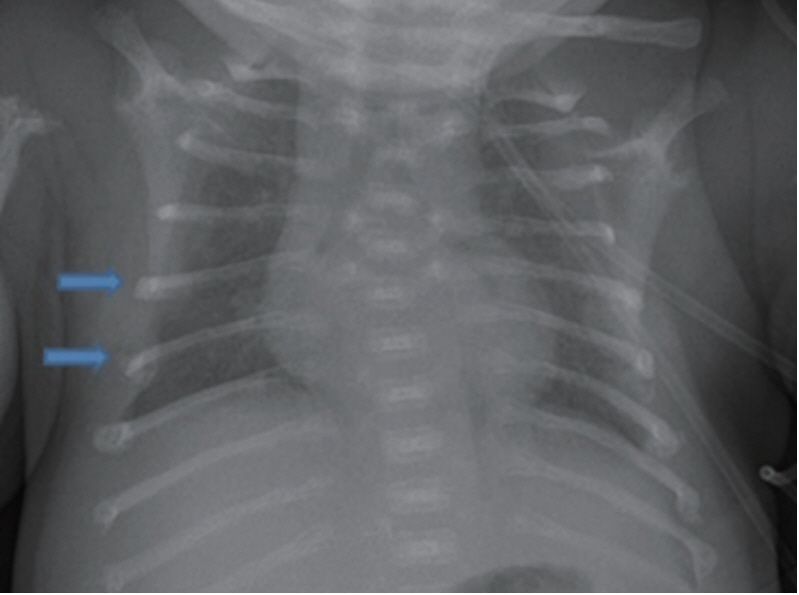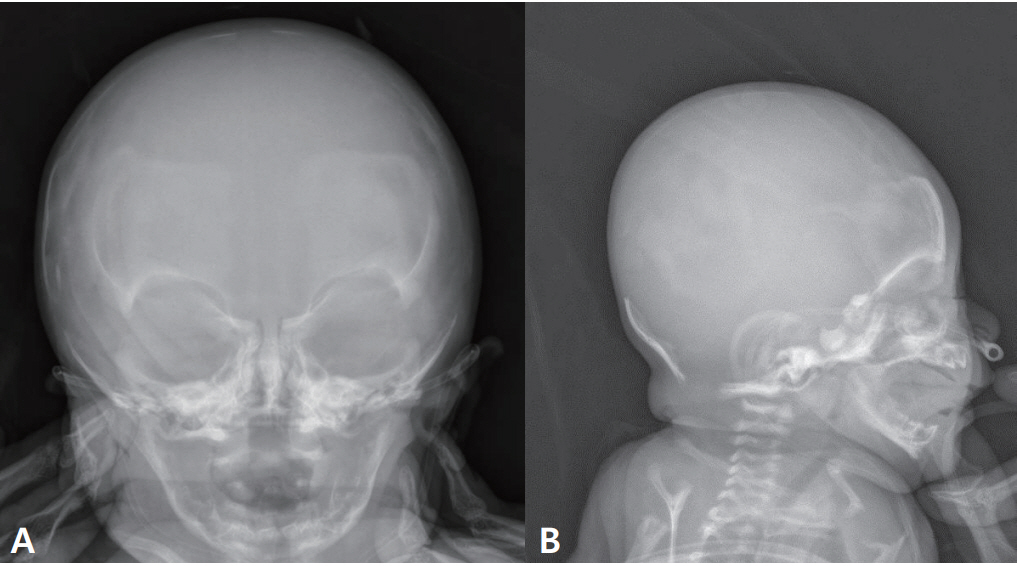Neonatal Med.
2020 Feb;27(1):26-30. 10.5385/nm.2020.27.1.26.
Case Report of Lethal Perinatal Hypophosphatasia with Seizure and Respiratory Failure Diagnosed by ALPL Gene Mutation
- Affiliations
-
- 1Department of Pediatrics, Daegu Fatima Hospital, Daegu, Korea
- KMID: 2502090
- DOI: http://doi.org/10.5385/nm.2020.27.1.26
Abstract
- Hypophosphatasia is a rare disease characterized by defective bone mineralization due to deficiency of tissue-nonspecific alkaline phosphatase. The patient was an 8-day-old male infant who presented with seizure since that day. Other symptoms included res piratory failure, requiring the use of a mechanical ventilator. Physical exami na tion revealed a large bulging anterior fontanelle, soft skull bone, and radial devia tion of both wrists. Laboratory examination showed normal serum calcium, low para thyroid hormone, normal 25-hydroxy vitamin D, and severely low alkaline phos phatase levels. Skeletal X-ray revealed dysplasia of the skull and cupping of the epiphysis of the limbs. Two heterozygous mutations (c.1052A>G, c.1559delT) of the ALPL gene were identified by Sanger sequencing. Thus, we report a case of confirmed lethal perinatal hypophos phatasia in Korea.
Figure
Reference
-
1. Mornet E. Hypophosphatasia. Orphanet J Rare Dis. 2007; 2:40.2. Mornet E. Genetics of hypophosphatasia. Arch Pediatr. 2017; 24:5S51–6.3. Michigami T, Uchihashi T, Suzuki A, Tachikawa K, Nakajima S, Ozono K. Common mutations F310L and T1559del in the tissuenonspecific alkaline phosphatase gene are related to distinct phenotypes in Japanese patients with hypophosphatasia. Eur J Pediatr. 2005; 164:277–82.4. Riancho-Zarrabeitia L, Garcia-Unzueta M, Tenorio JA, GomezGerique JA, Ruiz Perez VL, Heath KE, et al. Clinical, biochemical and genetic spectrum of low alkaline phosphatase levels in adults. Eur J Intern Med. 2016; 29:40–5.5. Mornet E, Yvard A, Taillandier A, Fauvert D, Simon-Bouy B. A molecular-based estimation of the prevalence of hypophosphatasia in the European population. Ann Hum Genet. 2011; 75:439–45.6. Shohat M, Rimoin DL, Gruber HE, Lachman RS. Perinatal lethal hypophosphatasia: clinical, radiologic and morphologic findings. Pediatr Radiol. 1991; 21:421–7.7. Whyte MP. Hypophosphatasia: aetiology, nosology, pathogenesis, diagnosis and treatment. Nat Rev Endocrinol. 2016; 12:233–46.8. Fallon MD, Teitelbaum SL, Weinstein RS, Goldfischer S, Brown DM, Whyte MP. Hypophosphatasia: clinicopathologic comparison of the infantile, childhood, and adult forms. Medicine (Baltimore). 1984; 63:12–24.9. Whyte MP, Murphy WA, Fallon MD. Adult hypophosphatasia with chondrocalcinosis and arthropathy. Variable penetrance of hypophosphatasemia in a large Oklahoma kindred. Am J Med. 1982; 72:631–41.10. Whyte MP. Hypophosphatasia and the role of alkaline phosphatase in skeletal mineralization. Endocr Rev. 1994; 15:439–61.11. Nakamura-Utsunomiya A, Okada S, Hara K, Miyagawa S, Takeda K, Fukuhara R, et al. Clinical characteristics of perinatal lethal hypophosphatasia: a report of 6 cases. Clin Pediatr Endo crinol. 2010; 19:7–13.12. Whyte MP, Greenberg CR, Salman NJ, Bober MB, McAlister WH, Wenkert D, et al. Enzyme-replacement therapy in lifethreatening hypophosphatasia. N Engl J Med. 2012; 366:904–13.13. Whyte MP, Leung E, Wilcox WR, Liese J, Argente J, Martos-Moreno GA, et al. Natural history of perinatal and infantile hypophosphatasia: a retrospective study. J Pediatr. 2019; 209:116–24.14. Park EG, Cho SY, Lee J, Kim J, Cho H, Kim J, et al. First Korean case of infantile hypophosphatasia with novel mutation in ALPL and literature review. Ann Clin Lab Sci. 2016; 46:302–7.15. Baumgartner-Sigl S, Haberlandt E, Mumm S, Scholl-Burgi S, Sergi C, Ryan L, et al. Pyridoxine-responsive seizures as the first symptom of infantile hypophosphatasia caused by two novel missense mutations (c.677T>C, p.M226T; c.1112C>T, p.T371I) of the tissue-nonspecific alkaline phosphatase gene. Bone. 2007; 40:1655–61.16. Reish O, Dolfin T, Arnon S, Regev R, Grinshpan G, et al. Glu274Lys/Gly309Arg mutation of the tissue-nonspecific alkaline phosphatase gene in neonatal hypophosphatasia associated with convulsions. J Inherit Metab Dis. 2002; 25:35–40.
- Full Text Links
- Actions
-
Cited
- CITED
-
- Close
- Share
- Similar articles
-
- Musculoskeletal and neurocognitive clinical significance of adult hypophosphatasia
- Lethal neonatal short-limbed dwarfism
- Short stature with low serum alkaline phosphatase activity: a case report of hypophosphatasia
- Bilateral Transverse (Bowdler) Fibular Spurs with Hypophosphatasia in an Adolescent Girl
- Hereditary Myopathy with Early Respiratory Failure with a Heterozygous TTN Gene Missense Mutation




